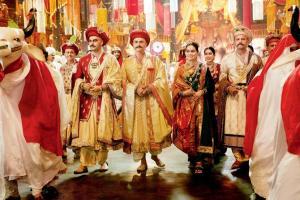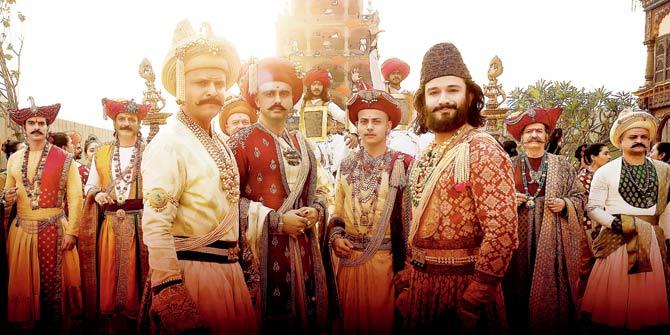Ashutosh Gowariker discusses the upcoming historical, Panipat, and the obvious comparisons between Ranveer Singh and his male leads.

Arjun Kapoor as Sadashiv Rao, Mohnish Bahl as Nanasaheb Pehwa and Padmini Koklhapure as Gopika Bai in a still from the film
The last time Ashutosh Gowariker made a historical epic, the world was a very different place. Facebook was far from being the government-toppling behemoth it is today, YouTube was three years old and Instagram wasn't even an embryo. Netflix had delivered its billionth DVD the previous year and Barack Obama's biggest concern was that he wasn't going to be able to keep his BlackBerry after he became President. Let's take a moment to review that. Netflix. was. a. DVD. rental. company. So when Jodhaa Akbar released in 2008, it released... it didn't drop.
It had been eight years since Gowariker was nominated for the Academy Awards but somehow, at the time, it seemed like it was just the previous year. He had since made just one movie, Swades (2004) and Jodhaa Akbar was a hotly anticipated film from an Oscar-nominated director. The sheen of accolades seemed to last longer back then, somehow. Even if Jodhaa Akbar had been a mediocre film, the Oscar-nominated tag suspended between two olive branches, would've been sufficient to carry it through. It gave Gowariker the liberty to indulge himself. Jodhaa Akbar ran for three hours and 20 minutes. He'd justified it back then saying the genre and the scale required that kind of runtime. Gowariker's next, Panipat, that marks his return to the genre runs at two hours and 45 minutes.
ADVERTISEMENT

Arjun Kapoor plays Sadashiv Rao, son of Chimaji Appa, younger brother to Peshwa Bajirao I
And so it is that on what passes off as winter morning in Mumbai, sun filtering through the tree canopies in a quiet Khar lane we find ourselves waiting for the man who's about to have yet another go at the box office. If the dismal performances of his last three films, What's Your Raashee? (2009), Khelein Hum Jee Jaan Sey (2010) and Mohenjo Daro (2016) , have affected him, Gowariker doesn't show it. He has the calm of a boxer before a bout, having shut out anything that could potentially distract him from his game.
But that hasn't meant he isn't aware of the changing world around him. "The fact is that audience viewing habits have evolved," he says, "And your approach to storytelling has to undergo a change too. The narrative pace has to be quicker and the script tighter. You can't insist on showing someone offering three salaams in an emperor's court, even though that was the prevailing norm, because the audience doesn't necessarily want to get that deeply involved in the tale. Skip cinematic manners to keep your audience engaged."
As a result, much of Gowariker's scripting process has undergone a change, especially with Panipat. He says, "At the script stage, how all the incidents are interwoven becomes important. There are so many characters involved in the story; you have to take a conscious decision, which ones to show and who to drop."

Pic/Avinash Gowariker
You would've thought that this kind of environment would be detrimental to historical epics. Yet, India has seen more movies in the genre than ever before. This year alone saw the release of Manikarnika and Kesari. The last year opened with Padmavat. Even though it wasn't rooted in history, 2017 was the year of the epic film Baahubali 2 , while 2015 saw the release of its precursor, Baahubali: The Beginning. The year 2015 was also the last time that the Maratha pride was on full display in Sanjay Leela Bhansali's Bajirao Mastani. Next year will see the release of the Ajay Devgn-starrer Tanaji and Akshay Kumar-starrer Prithviraj. There's a lot of period drama going around. For perspective, when Jodhaa Akbar hit the screens in 2008, comparisons were made to Mughal-e-Azam, a movie that released almost 50 years ago.
"The reason why we're getting to see more historical epics is because producers are willing to back these projects and actors are willing to act in them. Without these two, there's no way a movie can be made," Gowariker says matter-of-factly. It also helps that actors are now more open to experimenting. Panipat stars Arjun Kapoor as Sadashiv Rao, a nephew of Bajirao Peshwa and the commander-in-chief of the Maratha army. Sanjay Dutt plays Ahmad Shah Abdali, the Afghan emperor who invades the Maratha empire. Neither has a period film in their filmography. With Panipat, both the actors step into some very big shoes—that of Ranveer Singh. The maverick superstar has played both, a Peshwa (Bajirao) and a Muslim invader (Khilji), and comparisons between him, Kapoor and Dutt are bound to be drawn. "I can't let the fear of comparisons keep me from making my film," Gowariker says. "Even Arjun, when he was offered the role, didn't say, 'Oh, Ranveer has done something similar so let me avoid it'. He was inspired by the story, the character, and agreed immediately." As for Dutt, "When I asked him why he'd never done a period film, he said no one had asked him," Gowariker says doing a little Dutt impersonation.
There's no denying that even in the three-minute trailer Dutt's Abdali is reminiscent of Singh's Khilji, a portrayal that is considered by some as being problematic in the way it reduced the ruler to a meat-eating, sex-crazed, philistine. Some have called the portrayal Islamophobic. A reviewer called it a movie that "puts together every single stereotype of Muslims in India". Gowariker says that there was a conscious effort to make sure Dutt's Abdali didn't come across as being that. "I had kept that in mind while scripting. Panipat is about Maratha valour; it is about a protector and an invader and not about religion."
The battle of Panipat ended with a crushing Maratha defeat. According to Trimbak Shejwalkar's authoritative book on the subject, that also served as the bedrock of Gowariker's research, about one lakh Maratha soldiers and non-combatants were killed during and after the battle. But what sets it apart from movies such as Manikarnika, Kesari or even Padmavat is that this wasn't a last stand situation. At the time of the battle, the Marathas were a dominant force and, if anything, the battle was a clashing of two extremely powerful empires. It's also something should free the film from the toxic machismo of Akshay Kumar in Kesari and Ajay Devgn in the upcoming Tanhaji. In that, the casting of the easy-going Arjun Kapoor doesn't seem altogether off, despite the many memes.
It's also perfectly likely that Dutt's scowl and Kapoor's narrow range of expressions would be the movie's, how shall we put it, Waterloo, but something in the trailer suggests that Panipat is a dignified tale that celebrates valour and not victory. In this chest-beating moment of our country's history, Panipat could come as a welcome relief.
As we walk out of the building, we learn that the half dozen policemen guarding the entrance have been deployed to protect Gowariker from a fringe Maratha group threatening stir against the film. Gowariker isn't fazed. The right-wing tin-pot Karni Sena had threatened a similar stir during the release of Jodhaa Akbar. Eleven years have passed. Some things don't change.
1 lakh
Number of Maratha soldiers and non-combatants killed during and after the Third Battle of Panipat
Catch up on all the latest Mumbai news, crime news, current affairs, and also a complete guide on Mumbai from food to things to do and events across the city here. Also download the new mid-day Android and iOS apps to get latest updates
 Subscribe today by clicking the link and stay updated with the latest news!" Click here!
Subscribe today by clicking the link and stay updated with the latest news!" Click here!







